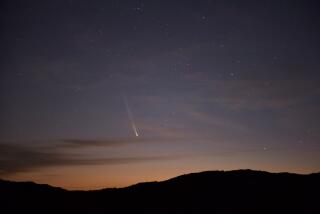‘Celebrity Comet’
- Share via
Comet Tempel 1 has received more attention than any other comet in the universe -- at least as far as we know!
Comets are part of our solar system, but we don’t see them very often. Lots of comets hang out (with Pluto) beyond the orbit of Neptune. This region is called the Kuiper (KY-per) Belt. Many more comets (maybe a trillion!) live much, much farther away in another region of the solar system called the Oort Cloud. Comets seem to be mostly ice with rocks and dirt mixed in. As a comet approaches the Sun, it gets warmed up and some of the ice boils off, taking some of the dust with it. This material forms a cloud -- a coma -- around the comet nucleus. And some of the material gets pushed into a tail by the solar wind. With its fuzzy coma and wispy tail, we may be able to see the comet from our own backyards!
But back to the fabulous Comet Tempel 1. Why is it so famous? Well, here’s the story.
On July 4, 2005, a spacecraft called Deep Impact released an 820-pound “impactor” probe right into the comet’s path -- on purpose. The impactor blasted a small crater into the comet’s surface and sent a plume of comet material into space. Meanwhile, the Deep Impact flyby spacecraft took pictures from below. Other spacecraft instruments studied the dust plume to figure out what the comet was made of. But there was so much dust kicked up that the spacecraft couldn’t see the crater.
Too bad.
But wait! Another spacecraft, called Stardust, had finished its mission at another comet, called Wild 2. Stardust still had lots of pep and no place to go.
“Let’s put Stardust back to work,” the NASA scientists said. So they planned another mission for Stardust, now called Stardust-NExT (for New Exploration of Tempel 1). It would have another look at Comet Tempel 1.
So, on Feb. 14, 2011, NASA again met Comet Tempel 1. By this time, Tempel 1 was a little older and a little more “worn out.” Like all comets, when it was closest to the sun, it had warmed up, and some of its surface had evaporated, creating the comet’s coma and tail.
Stardust-NExT found the 500-foot crater left by Deep Impact. Scientists are studying the crater’s rim to see if it’s a little worn down. The blasted out material had settled into a mound in the center of the crater. Other formations had also changed. Scientists are studying the information from the two missions to Comet Tempel 1. What else will they discover about comets?
The Space Place has lots of fun facts, games, and puzzles about comets and NASA’s comet missions. Go to spaceplace.nasa.gov and enter “comets” in the “Find it @ Space Place” field.
--
This article was provided by the Jet Propulsion Laboratory, California Institute of Technology, under a contract with the National Aeronautics and Space Administration.
For more Kids’ Reading Room, visit latimes.com/kids.
More to Read
Sign up for our Book Club newsletter
Get the latest news, events and more from the Los Angeles Times Book Club, and help us get L.A. reading and talking.
You may occasionally receive promotional content from the Los Angeles Times.








